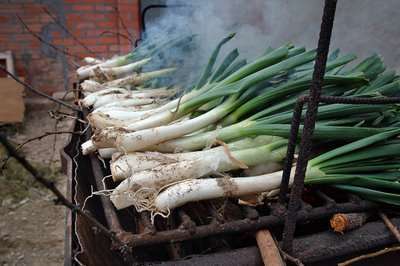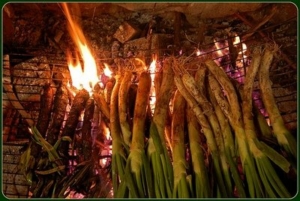Traditional Spanish Calçots 2010
Calçots were discovered by a Catalan farmer called Xat de Benaiges at the end of the 19th century. The cultivation of Calçots is a complicated process that starts at the end of the year when onion seeds are planted. Once the onion has germinated and begun to grow, it is pulled out of the ground and stored for a time before being replanted. It is only buried half way into the earth and as it grows higher, it is necessary to repack earth around the newly grown part of the vegetable. When harvested it has the long leek like appearance that most people living here know and love.
The Calçotada became a family feast celebration in the first few decades of the twentieth century. However, it wasn’t until 1983 that a small town in Catalunya, Valls, undertook the first communal Calçotada to which anyone can go. Other areas in Catalonia produce Calçots but Valls proudly lays claim to its role as founder of the Calçot tradition. The calcots are normally cooked on a barbecue and turned and turned until entirely blackened outside and soft and sweet within, but in Vals they are cooked on burning vines. On the streets of Valls you can stand at a long table and grasp a fire blackened calcot in your hands (don´t worry about getting your fingers dirty, it is all part of the fun) before peeling off the burned outer skin; dipping it into a Romesco sauce made from pepper, almonds, garlic and oil and thrusting it speedily into your mouth before it drips. Traditionally, sausages or lamb are served up after the calçots followed by Crema Catalana.
Should you decide to order Calçots in a restaurant, you will first of all be handed a bib to wear to save your clothes from the dripping sauce and perhaps even a pair of gloves to additionally protect your fingers from the burned flesh of the delicacy. The calcots will be brought to your table in a great blackened mound on a rounded roof tile to keep them warm and with great ceremony, will be placed in the centre for all to share; as ever, the very tasty Romesco sauce will be at hand for “dipping”. Needless to say girls, after a Calçotada is not the time to go off in search of a new friend…..your teeth will be blackened and witchlike, but what terrific fun and quite one of the most delicious ways in which to get some of your five a day!
To enjoy this experience first hand, join Gourmand Breaks for a private Food and Wine Tour during the Calçot season which lasts from the end of January until the end of April /May- in true Catalan tradition you will go authentic restaurants and eat calçots in the open air-theres nothing quite like it!




